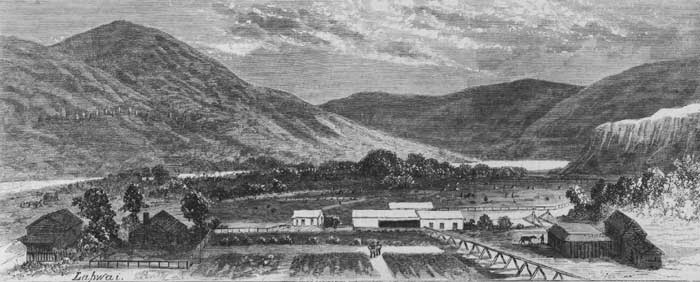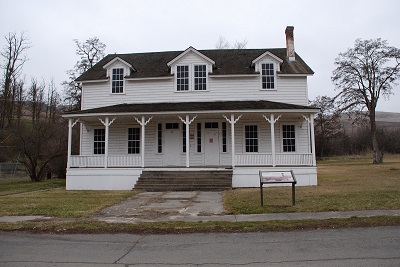
Fort Lapwai: From Frontier Outpost to Heart of Nez Perce Resilience
LAPWAI, Idaho – Nestled in the rolling hills of north-central Idaho, where the Lapwai Creek gently flows into the Clearwater River, lies a place rich with layers of history, struggle, and profound resilience. Today, Lapwai is the vibrant administrative heart of the Nez Perce Tribe (Nimiipuu), a beacon of self-determination and cultural revitalization. Yet, beneath the surface of this modern tribal hub, and often standing in quiet juxtaposition to its present, lies the complex and sometimes painful legacy of Fort Lapwai – a military outpost that once symbolized federal power and the dramatic reshaping of the American West.
The story of Fort Lapwai is inextricably linked to the Nez Perce people, their ancient lands, and the relentless march of westward expansion. It is a narrative that encompasses broken treaties, armed conflict, forced assimilation, and ultimately, the enduring spirit of a nation determined to reclaim its heritage and future.

The Genesis of a Frontier Post: Conflict and Containment
To understand Fort Lapwai, one must first grasp the context of the mid-19th century in Idaho Territory. The Nez Perce, historically known for their peaceful demeanor and extensive territory spanning parts of present-day Idaho, Oregon, and Washington, had initially maintained relatively good relations with American settlers and explorers, famously aiding the Lewis and Clark expedition. The Treaty of 1855 solidified their vast ancestral lands, a domain of some 7.5 million acres.
However, this peace was fragile. The discovery of gold in the Clearwater River region in 1860 triggered an unstoppable influx of prospectors and settlers, encroaching upon Nez Perce lands. Tensions escalated rapidly. The U.S. government, seeking to manage the growing conflict and protect its citizens (as well as to facilitate further land acquisition), established Fort Lapwai in 1862. Its name, "Lapwai," is derived from the Nez Perce word "Lapwaii," meaning "place of the butterflies" or "butterfly water," a poignant contrast to the military purpose it would soon embody.
Initially a temporary camp, Fort Lapwai became a permanent post in 1863, strategically located near the newly established Nez Perce Reservation. That same year, the infamous "Thief Treaty" was imposed. This treaty, signed by a minority of Nez Perce chiefs without the consent of the majority, drastically reduced the reservation to a mere tenth of its 1855 size, stripping away millions of acres, including the cherished Wallowa Valley – the homeland of Chief Joseph’s band.
This act of dispossession laid the groundwork for future conflict. Chief Joseph, whose Nez Perce name was Hinmatóowyalahtq̓it ("Thunder Rolling Down the Mountain"), famously stated, "The earth is our mother. We cannot sell the earth." His words echoed the sentiment of many non-treaty Nez Perce, who refused to acknowledge the legitimacy of the 1863 treaty and continued to live on their ancestral lands outside the new reservation boundaries.
The Crucible of War: 1877
Fort Lapwai’s most significant, and tragic, role came in 1877. By then, it served as the headquarters for the U.S. Army’s Department of the Columbia, commanded by General Oliver O. Howard. The government’s patience with the non-treaty Nez Perce had run out. Howard was ordered to force Chief Joseph’s band, along with those of Looking Glass, White Bird, and Toohoolhoolzote, onto the Lapwai Reservation.
On June 14, 1877, just days before the deadline for the Nez Perce to move, a small group of warriors, enraged by years of injustice and the murder of a tribal elder, retaliated against white settlers in the Salmon River area. This act, though condemned by Chief Joseph, ignited what would become known as the Nez Perce War.
From Fort Lapwai, General Howard launched his campaign. The fort became a staging ground, a supply depot, and a communication hub for the pursuing troops. The war was a remarkable 1,170-mile odyssey of the Nez Perce, who, numbering only about 700 people (with fewer than 200 warriors), outmaneuvered and outfought thousands of U.S. soldiers across four states for over three months, attempting to reach sanctuary in Canada.
"My people have no country," Chief Joseph declared during this arduous flight. "They are like deer. They are hunted by white men." Though the Nez Perce displayed extraordinary courage and tactical brilliance, their journey ended in heartbreak just 40 miles short of the Canadian border, with Chief Joseph’s famous surrender speech: "From where the sun now stands, I will fight no more forever." The Nez Perce War, a direct consequence of the policies enforced from places like Fort Lapwai, stands as a brutal testament to the cost of manifest destiny.
From Military Post to Assimilation Tool: The Indian Agency
After the Nez Perce War, Fort Lapwai’s military function gradually diminished. By 1884, the post was officially abandoned by the Army and transferred to the Department of the Interior’s Bureau of Indian Affairs. This marked a significant, though equally challenging, new chapter for the site.
The former military barracks and officer quarters were repurposed to serve the Lapwai Indian Agency, responsible for administering federal policies to the Nez Perce confined to the reservation. This era was characterized by a pervasive federal push for Native American assimilation, often summarized by the grim philosophy, "Kill the Indian, save the man."
A key instrument of this policy was the Lapwai Indian Boarding School. Established on the former fort grounds, the school aimed to strip Nez Perce children of their language, culture, and traditional ways of life. Children were often forcibly removed from their families, forbidden to speak Nez Perce, and taught trades and customs deemed "civilized" by the dominant white society. The trauma inflicted by these schools, designed to erase indigenous identity, continues to resonate through generations of Nez Perce families.
"My grandmother told stories of being punished for speaking Nez Perce in school," recalls a contemporary Nez Perce elder, whose family members attended Lapwai. "They cut her hair, changed her clothes, and tried to teach her to forget who she was. But they couldn’t break her spirit, or our spirit."
The agency also oversaw the allotment of reservation lands, a policy that broke up communally held tribal lands into individual parcels, further eroding traditional social structures and often leading to the loss of land through sale or taxation to non-Nez Perce.
The Nez Perce Today: Reclaiming Identity and Sovereignty
The 20th century saw the Nez Perce, like many other Native American tribes, endure the long-term effects of these federal policies. Yet, through it all, their culture, language, and spiritual connection to their land persisted. The latter half of the century brought a renewed focus on tribal sovereignty and self-determination.
Today, Lapwai stands as a powerful symbol of this resilience and resurgence. The former fort grounds are now home to the Nez Perce Tribal Executive Committee (NPTEC) complex, the administrative and governmental center of the Nez Perce Nation. Modern buildings house offices for tribal council members, resource management departments, education programs, and health services.
The Nez Perce Tribe is actively engaged in managing its natural resources, promoting economic development, and preserving its unique culture. The Nimiipuu Health clinic provides essential healthcare services, reflecting a commitment to community well-being. Education remains a priority, with tribal programs supporting students from early childhood through higher education, ensuring that future generations are equipped to lead.
Crucially, there is a vibrant movement to revitalize the Nez Perce language (Nimiipuutímt), an effort to reclaim a vital part of their identity that was nearly lost due to the boarding school era. Cultural events, traditional arts, and storytelling are celebrated, weaving the past into the fabric of the present. The Nez Perce National Historical Park, with sites across Idaho, Oregon, Montana, and Washington, tells the story of the Nez Perce people from their ancient origins to the present, ensuring that their narrative is heard and understood.
"We stand on the shoulders of our ancestors," states a current tribal leader, reflecting on the historical site. "This ground, where soldiers once sought to control us, now serves as the foundation for our self-governance. It’s a testament to the strength and perseverance of the Nimiipuu that we are not just surviving, but thriving, and shaping our own future."
A Legacy of Transformation
Fort Lapwai’s physical remnants are few, largely integrated into the modern tribal community. Yet, its story remains deeply etched into the landscape and the collective memory of the Nez Perce. It serves as a powerful reminder of the profound shifts in power, the injustices inflicted, and the enduring strength required to overcome them.
From a military outpost enforcing federal will, to an Indian Agency attempting to erase an entire culture, the site of Fort Lapwai has undergone a profound transformation. It is no longer a symbol of external control but rather the beating heart of a sovereign nation, a place where the Nez Perce continue to define their identity, protect their heritage, and forge a future rooted in their traditions and aspirations. The echoes of bugle calls and military drills have long faded, replaced by the vibrant sounds of community, culture, and self-determination – a testament to the indomitable spirit of the Nez Perce people.



